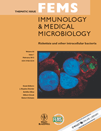Foxp3+CD4+CD25+ regulatory T cells are increased in patients with Coxiella burnetii endocarditis
Abstract
Chronic Q fever, which principally manifests as endocarditis, is characterized by Coxiella burnetii persistence and an impaired cell-mediated immune response. The long-term persistence of pathogens has been associated with the expansion of regulatory T cells (Tregs), the CD4+ T-cell subset that is characterized by the expression of CD25 and Foxp3. We investigated the presence of Tregs in patients with acute Q fever (n = 17), known to exhibit an efficient immune response, patients with Q fever endocarditis (n = 54) and controls (n = 27) by flow cytometry. The proportion of CD3+, CD4+ and CD8+ T cells was similar in controls and patients with Q fever. The percentage of CD4+ T cells that expressed CD25 was similar in controls and patients with Q fever. The population of CD4+ T cells that expressed both CD25 and Foxp3 was significantly (P < 0.001) increased in patients with Q fever endocarditis compared with controls. Our data suggest that the expansion of Tregs may be critical for the chronic evolution of Q fever.




